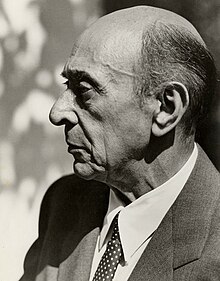
The term expressionism "was probably first applied to music in 1918, especially to Schoenberg", because like the painter Wassily Kandinsky (1866–1944) he avoided "traditional forms of beauty" to convey powerful feelings in his music.[1] Theodor Adorno interprets the expressionist movement in music as seeking to "eliminate all of traditional music's conventional elements, everything formulaically rigid". This he sees as analogous "to the literary ideal of the 'scream.' " As well Adorno sees expressionist music as seeking "the truthfulness of subjective feeling without illusions, disguises or euphemisms". Adorno also describes it as concerned with the unconscious, and states that "the depiction of fear lies at the centre" of expressionist music, with dissonance predominating, so that the "harmonious, affirmative element of art is banished".[2] Expressionist music would "thus reject the depictive, sensual qualities that had come to be associated with impressionist music. It would endeavor instead to realize its own purely musical nature—in part by disregarding compositional conventions that placed 'outer' restrictions on the expression of 'inner' visions".[3]
Expressionist music often features a high level of dissonance, extreme contrasts of dynamics, constant changing of textures, "distorted" melodies and harmonies, and angular melodies with wide leaps.[4]
- ^ Sadie 1991, 244.
- ^ Adorno 2009, 275–276.
- ^ Carrasco 2020.
- ^ Anon. 2014.